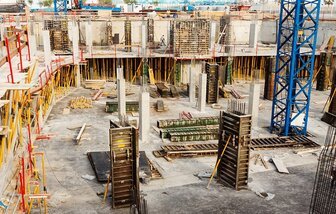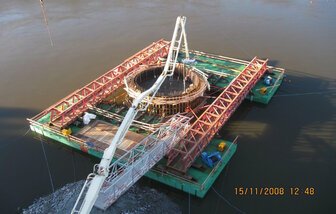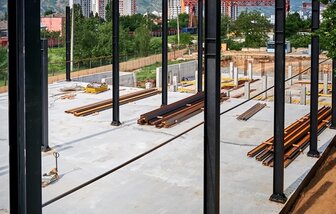Piled Raft Foundation
Discover the innovative concept of piled raft foundations, which combines the benefits of piled and raft foundations to create a robust solution for various construction needs. This method effectively distributes structural loads, minimizes differential settlement, and offers support in weaker soil conditions. Explore the advantages including cost-effectiveness, reduced material requirements, and the enhancement of overall structural integrity. Whether you're an architect, engineer, or construction professional, understanding pile raft foundations can significantly impact your project's success and longevity.
Understanding Piled Raft Building Foundation: A Modern Construction Technique
In the realm of construction, establishing a solid foundation is crucial for the integrity and durability of any structure. Among the innovative techniques architects and engineers are increasingly adopting is the pile raft building foundation.
This system distinctly merges the advantages of both pile foundations and raft foundations, delivering a robust and efficient solution for various construction projects.
What is a Piled Raft Foundation?
The pile raft building foundation, often referred to as a piled raft foundation, consists of strategically placed piles beneath the entire building footprint, interconnected by a reinforced concrete raft slab.
This unique combination effectively distributes the load of the structure across both the piles and the raft, enhancing stability and mitigating the risk of excessive settlement over time.
Advantages of Using Piled Raft Foundation
Implementing a pile raft foundation system offers several benefits. First, it minimizes differential settlement, which can lead to structural issues. Second, the integration of piles provides support in weaker soil conditions, where a traditional foundation may not suffice.
Lastly, this method is often more cost-effective, as it reduces the amount of material and labor needed compared to some traditional foundation solutions, all while maintaining the structural integrity of the building.

Piled raft foundations have gained popularity in the UK due to their unique construction benefits. This innovative approach combines a raft foundation with piles, providing an effective solution for various soil conditions and structural requirements. Understanding the advantages this type of foundation offers can guide engineers and architects in making informed decisions for their projects.
Enhanced Load-Bearing Capacity
One of the primary advantages of using piled raft foundations is the enhanced load-bearing capacity. By distributing loads over both the raft and the piles, this foundation type minimizes the risk of differential settlement in structures. This is particularly beneficial in UK regions with varying soil stability, ensuring that buildings withstand harsh conditions over time.
Cost-Effective Solutions
Piled raft foundations can also prove to be cost-effective, as they reduce the need for extensive excavation and soil replacement. By utilizing existing soil layers effectively, construction time and costs are minimized. Furthermore, the reduction in materials required for conventional foundations leads to lowered overall expenditures, making this solution appealing to developers and investors alike.
Environmental Benefits
In addition to financial advantages, piled raft foundations contribute positively to environmental considerations. This type of foundation minimizes the disturbance to the surrounding ecosystem during construction. The reduced footprint and minimal use of heavy machinery help protect the local environment, aligning with the growing emphasis on sustainable building practices in the UK.
Overall, the advantages of piled raft foundations, including enhanced load-bearing capacity, cost-effectiveness, and environmental friendliness, make them an attractive choice for developers across the UK. By leveraging these benefits, engineers can ensure safer and more sustainable buildings for the future.
The design and construction of a pile raft building foundation require careful analysis of the site conditions, soil properties, and structural requirements. Typically, the process involves the following steps:
- Site Investigation: A thorough geotechnical investigation is conducted to assess the soil conditions, including bearing capacity, settlement characteristics, and groundwater levels.
- Structural Design: Based on the site investigation, the structural engineer determines the optimal arrangement of piles and the dimensions of the raft slab to ensure stability and meet the load requirements.
- Pile Installation: Piles are installed using various methods, such as driven piles, bored piles, or helical piles, depending on the soil conditions and project specifications.
- Raft Construction: Once the piles are in place, a reinforced concrete raft slab is constructed, connecting all the piles and providing a stable platform for the building.
- Monitoring and Maintenance: Regular monitoring and maintenance of the pile raft foundation are essential to ensure its long-term performance and structural integrity.
Piled raft foundations have gained popularity in the UK for their ability to support heavy structures. However, there are notable disadvantages that must be considered before opting for this construction method. Understanding these drawbacks is essential for architects, engineers, and construction stakeholders.
High Costs Involved
One significant disadvantage of piled raft foundations is the initial investment required. The combination of piling and raft construction often results in overall higher costs compared to traditional foundations. This cost can escalate due to unforeseen geological conditions or the need for specialized equipment, which can burden project budgets.
Complex Design and Construction Requirements
The design and implementation of piled raft foundations demand a high level of expertise. The complexities involved require precise calculations to ensure stability, which can lead to longer planning and approval times. Additionally, the interaction between piles and the raft complicates the construction process, increasing the likelihood of construction delays.
Potential Environmental Impact
Piled raft foundations can negatively affect the surrounding environment. The installation of piles requires extensive drilling and excavation, which can disrupt local ecosystems. Moreover, the vibration from pile driving may disturb nearby structures and wildlife, fostering concerns about long-term sustainability practices.
Conclusion
While piled raft foundations provide significant benefits under certain conditions, stakeholders must weigh their disadvantages carefully. From high costs and complex construction to environmental concerns, understanding these drawbacks can aid in making informed decisions in foundation design and construction.
Pile raft foundations represent a modern engineering solution, specifically designed to address the challenges posed by poor soil conditions. By integrating the load-bearing capacity of piles with the stability of raft slabs, this foundation system meets the demands of various construction projects effectively.
Advantages of Pile Raft Foundations
One of the primary benefits of pile raft foundations is their enhanced structural integrity. This combination allows for significant weight distribution across a broader area, which mitigates issues related to settlement. In addition to improved stability, pile raft foundations also present cost-effective solutions for both residential and industrial projects.
Applications and Considerations
When designed and constructed carefully, pile raft foundations can support an extensive range of constructions, from modest residential units to vast industrial complexes. The versatility of this foundation type makes it an attractive option for developers, particularly when working with challenging terrain. It is important to consult with experienced engineers to ensure the foundation is tailored to specific project needs.
Soft Strip foundations
Learn about soft strip foundations, a type of shallow strip foundation commonly used in the United Kingdom. Discover how they work, their advantages, and considerations to keep in mind
Trench fill foundation
Trench fill foundations are similar to strip foundations but differ in that the trench is filled with concrete rather than individual concrete or masonry blocks.
Piled foundation
Piled foundations are used when the soil conditions are challenging or when the load on the foundation is particularly heavy. This type of foundation involves driving or drilling deep piles into the ground
What is a raft foundation?
Raft foundations are a popular choice for many construction projects, providing a stable and durable base for buildings. Explore the benefits of raft foundations, the construction process
Piled raft foundation
Piled raft foundations combine the advantages of piled foundations and raft foundations. They involve the use of both piles and a large concrete slab to distribute the load over a wider area.
Caisson foundation
Caisson foundations, also known as pier foundations, are used in areas with a high water table or poor soil conditions. This type of foundation involves drilling or excavating
Pad foundation
Pad foundations, also known as isolated footings, are used to support individual columns or posts. They consist of a single concrete pad that distributes the load from the column to the soil
Building foundation hub
At Total, we are dedicated to providing you with the essential knowledge and resources you need to build a strong foundation in various fields. Whether you are a student, professional, or simply curious a
Ready to start your project ?
Let's Work Together
To get started, for general enquiries simply complete the form below. Provide us with your project details, and our team will review your requirements. We will then get back to you with a customised solution that fits your needs. Whether you have a small-scale project or a large-scale development, we have the expertise and resources to handle it. Once we have received your submission, you will receive a confirmation email (Please check all your email boxes)
If you prefer, and have a project in mind and seeking a price you can also send us your project documents and any photographs directly to admin@totalgroundworks.co.uk We will carefully examine your documents and provide you with a competitive quote together with a timescale from inception through to completion for your project.








